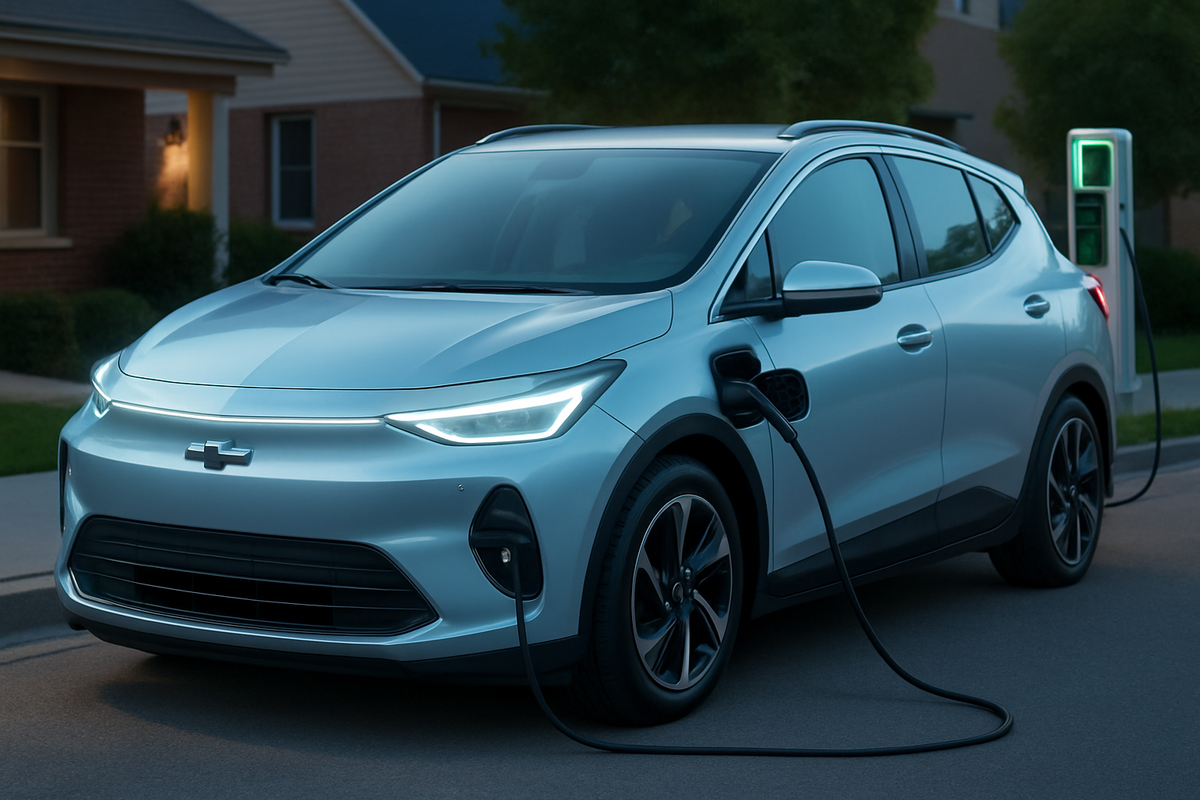
Detroit, MI – October 10, 2025 – In a strategic move poised to send ripples across the automotive landscape, Chevrolet (NYSE: GM) has officially announced the revival of its beloved Bolt EV for the 2027 model year. This highly anticipated return promises to redefine the entry-level electric vehicle (EV) segment, offering an impressive range, cutting-edge technology, and an aggressive starting price of $29,990. The decision to bring back the Bolt, following its discontinuation in 2023, underscores General Motors' (NYSE: GM) renewed commitment to making electric mobility accessible to a broader consumer base, directly addressing the growing demand for affordable, practical EVs.
This revival is more than just a reintroduction; it's a strategic recalibration aimed at solidifying Chevrolet's position in the mass-market EV space. By leveraging GM's advanced Ultium platform, the 2027 Bolt EV is set to deliver significant improvements in performance, charging capabilities, and overall value. Its aggressive pricing strategy, which includes an even more affordable LT variant later in the model year starting at $28,995, is expected to intensify competition and accelerate the mainstream adoption of electric vehicles across North America.
A Bold Comeback: The 2027 Bolt EV's Unveiling
The 2027 Chevrolet Bolt EV is not merely a nostalgic return; it's a forward-looking vehicle designed to meet the evolving demands of the modern EV driver. Production is slated to begin in early 2026 at GM's Fairfax Assembly plant in Kansas City, Kansas, with customer deliveries commencing in the first quarter of 2026. This swift turnaround highlights GM's agility in responding to market feedback and its commitment to a robust EV future.
Underneath its familiar, yet refreshed, Bolt EUV-esque exterior, the 2027 Bolt boasts a suite of significant upgrades. It will be powered by GM's in-house X76 electric drive unit, shared with the Chevrolet Equinox EV, delivering 210 horsepower and 169 pound-feet of torque to the front wheels. A new 65-kWh lithium-iron-phosphate (LFP) battery, known for its cost-effectiveness and durability, will provide a GM-estimated 255 miles of range on a full charge – making it the most range in an EV under $30,000. Crucially, the LFP battery allows for charging to 100% capacity without concerns about long-term degradation.
A major technological leap is the inclusion of a native North American Charging Standard (NACS) port, making the Bolt the first Chevrolet vehicle to offer direct compatibility with Tesla's (NASDAQ: TSLA) extensive Supercharger network without an adapter. DC fast charging speeds have been dramatically improved to a peak of 150 kW+, allowing a 10% to 80% charge in just 26 minutes. Furthermore, the 2027 Bolt will offer vehicle-to-home (V2H) bidirectional charging capability, a feature that allows the car to power a home during outages when paired with GM's Energy Home System. The interior has been redesigned for a more driver-centric experience, featuring a larger 11.3-inch infotainment touchscreen with Google built-in and an 11-inch digital driver information screen. Notably, it will not support Apple CarPlay or Android Auto, relying instead on the integrated Google system. For added convenience and safety, the Bolt will offer available Super Cruise hands-free driver assistance technology and over 20 standard safety features.
Market Dynamics: Winners and Losers in the EV Race
The reintroduction of the 2027 Chevrolet Bolt EV is poised to significantly reshape the competitive landscape of the electric vehicle market, creating clear winners and presenting new challenges for existing players.
General Motors (NYSE: GM) stands as a primary winner. The Bolt's revival, leveraging the cost efficiencies of the Ultium platform and LFP batteries, solidifies Chevrolet's position in the crucial affordable EV segment. This move, alongside the Equinox EV, is projected to account for the majority of Chevrolet's EV sales volume in 2026, directly addressing the cost barrier to EV adoption. The native NACS port is a significant draw, providing Bolt owners seamless access to Tesla's vast Supercharger network, enhancing convenience and reducing range anxiety. This strategic deployment of accessible EVs reinforces GM's "EVs for everyone" vision and demonstrates its ability to adapt to market demands for affordability.
Conversely, several competitors face increased pressure. Tesla (NASDAQ: TSLA), while dominating the premium EV market, lacks a direct competitor in the sub-$30,000 segment. The Bolt offers a compelling, affordable alternative that could impact Tesla's growth rate in the mass market, even as Tesla benefits from NACS adoption. Automakers like Ford (NYSE: F), whose current EV lineup is in higher price brackets, will feel pressure to accelerate the development and release of their own planned affordable EVs. Similarly, Hyundai (KRX: 005380) and Kia (KRX: 000270), strong players in the affordable and mid-range EV segments with models like the Kona EV and Niro EV, will face intense competition, potentially forcing them to lower prices or enhance features. Nissan (TYO: 7201), whose Leaf previously held the title of America's most affordable new EV, will be directly undercut by the Bolt's aggressive pricing and superior charging capabilities. The Bolt's return is likely to spark a broader trend of price reductions and feature enhancements across the entire budget EV segment, benefiting consumers but challenging manufacturers to maintain profitability.
Wider Significance: A Catalyst for Mass EV Adoption
The 2027 Chevrolet Bolt EV's reintroduction is more than just a product launch; it's a pivotal moment that reflects and influences several broader industry trends, particularly the push for EV affordability and mass-market adoption. Its aggressive pricing directly addresses the historical perception of EVs as expensive, exclusive vehicles, aligning with a global movement to make electric transportation accessible to the average consumer.
This event fits squarely into the trend of declining battery costs, which have plummeted by nearly 90% from 2010 to 2023. By leveraging cost-effective LFP batteries and the modular Ultium platform, GM demonstrates a viable path to offering competitive EV pricing without heavy reliance on government incentives. This strategy is likely to ripple through the industry, encouraging other manufacturers to adopt similar standardized platforms and cost-reduction techniques to achieve economies of scale. The integration of a native NACS charging port further signifies a move towards a unified charging standard in North America, simplifying the EV experience for consumers and reducing range anxiety, a critical factor for mass adoption.
From a regulatory perspective, the Bolt's launch without the direct benefit of federal tax credits (which have expired for many models) provides a crucial test case for the market's organic demand. Its manufacturing location in Kansas helps it avoid certain tariffs and could position it for any future domestic manufacturing incentives. Historically, the Bolt's initial launch in 2017 was groundbreaking for offering a 200-mile-plus range at an affordable price, much like the Ford (NYSE: F) Model T democratized car ownership in the early 20th century. The 2027 Bolt aims to replicate this impact, acting as a catalyst for mainstream EV adoption and pushing the entire industry towards a more affordable and sustainable future.
What Comes Next: The Road Ahead for Affordable EVs
The return of the 2027 Chevrolet Bolt EV sets the stage for a dynamic future in the affordable EV segment, with both short-term and long-term implications for General Motors and its competitors.
In the short-term (2025-2027), the Bolt's aggressive pricing is expected to intensify competition, forcing other automakers to respond with their own affordable offerings or price adjustments. We can anticipate increased focus on LFP battery technology for cost efficiency and a continued push towards NACS integration across the industry, further standardizing charging infrastructure. General Motors (NYSE: GM) will be closely watched to see if the "limited run model" designation for the Bolt translates into controlled production volumes or if overwhelming demand leads to expansion. The Bolt, alongside the Equinox EV, is projected to constitute the majority of Chevrolet's EV sales volume for 2026, highlighting GM's strategic pivot towards accessible electric mobility.
Looking long-term (beyond 2027), the success of the 2027 Bolt could accelerate the development of even more affordable EVs globally, potentially leading to a market where EV prices are fully competitive with, or even lower than, comparable internal combustion engine (ICE) vehicles. Strategic pivots for GM will include continuous optimization of the Ultium platform, further investments in battery technology (e.g., solid-state batteries), and expanding V2H capabilities to enhance the value proposition of its EVs. Competitors will likely focus on diversified offerings, including compact city EVs and potentially more hybrid options, to cater to various consumer segments. Market opportunities will emerge in developing regions where affordability is paramount, as well as in the commercial and fleet vehicle sectors. Challenges will persist around charging infrastructure gaps, supply chain resilience for critical minerals, and overcoming residual consumer skepticism regarding battery longevity and range. Potential scenarios range from rapid mainstream adoption driven by widespread affordability to a more moderate, phased growth if infrastructure or economic headwinds persist.
Comprehensive Wrap-up: Driving Towards an Electric Future
The revival of the 2027 Chevrolet Bolt EV marks a significant turning point in the electric vehicle revolution. It underscores a crucial shift in the automotive industry's focus: from early adoption driven by luxury and performance to mass-market acceptance propelled by affordability and practicality.
Key takeaways from this announcement are clear: General Motors (NYSE: GM) is doubling down on its commitment to accessible electric mobility, leveraging its advanced Ultium platform to deliver a compelling EV at an unbeatable price point. The inclusion of new tech features, faster charging, a native NACS port, and V2H capabilities significantly enhances the Bolt's value proposition. This move directly addresses the primary barrier to wider EV adoption – cost – and positions the Bolt as a frontrunner in the burgeoning affordable EV segment.
Assessing the market moving forward, the 2027 Bolt is expected to act as a powerful catalyst. It will intensify competition, prompting other automakers like Tesla (NASDAQ: TSLA), Ford (NYSE: F), Hyundai (KRX: 005380), and Kia (KRX: 000270) to accelerate their efforts in offering more budget-friendly and feature-rich EVs. The emphasis on cost-effective LFP batteries and standardized charging infrastructure will likely become industry norms, streamlining the transition for consumers. While the expiration of federal tax credits presents a challenge, GM's strategic pricing and potential for automaker-led incentives aim to sustain demand.
Final thoughts on significance and lasting impact: The 2027 Bolt EV's return could be a defining moment for the mainstream adoption of electric vehicles. By making a capable, modern EV genuinely affordable, GM is not just selling a car; it's selling the future of personal transportation to the masses. Its success will demonstrate that EVs can compete on price with traditional gasoline vehicles, fundamentally altering consumer perceptions and accelerating the global shift towards electrification.
Investors should watch for several key indicators in the coming months. For General Motors (NYSE: GM), monitor the profitability of its EV segment, its ability to scale Ultium platform production efficiently, and the sales performance of the new Bolt and Equinox EV. Observe how GM's strategy of balancing ICE profits with EV investments unfolds. More broadly, investors should track overall EV market penetration, especially in the affordable segment, global battery cost trends, advancements in charging infrastructure, and the competitive responses from other major automakers and emerging players. The ongoing evolution of government policies and incentives will also remain a critical factor shaping the EV landscape.
This content is intended for informational purposes only and is not financial advice




